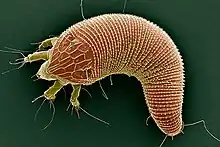Rose rosette emaravirus
Rose rosette emaravirus (RRV) is a negative sense RNA virus[1] species of virus in the order Bunyavirales.[2] It is known to infect roses (Rosa spp.), in which it causes witch's broom and sometimes excessive growth of prickles. The virus is transmitted by a microscopic Eriophyid mite Phyllocoptes fructiphilus.[3] The disease takes 3-4 years to properly phenotype and thus is a hard disease to breed resistance to the virus.[4] Breeding work began with cultivar resistance trials and then morphed into bi-parental and interconnected populations for mapping disease resistance. Recently there have been the first two studies identifying loci for resistance on both the diploid and tetraploid level using mapping populations developed at Texas A&M University Rose Breeding and Genetics Program.[5] On the diploid level, QTL were found on linkage groups (LGs) 1, 3, 5, and 6 [6] and on the tetraploid level, QTL were found on LGs 5, 6, and 7.[7]
| Rose rosette emaravirus | |
|---|---|
 | |
| Virus classification | |
| (unranked): | Virus |
| Realm: | Riboviria |
| Kingdom: | Orthornavirae |
| Phylum: | Negarnaviricota |
| Class: | Ellioviricetes |
| Order: | Bunyavirales |
| Family: | Fimoviridae |
| Genus: | Emaravirus |
| Species: | Rose rosette emaravirus |

References
- Laney, Alma G.; Keller, Karen E.; Martin, Robert R.; Tzanetakis, Ioannis E.YR 2011 (2011). "A discovery 70 years in the making: characterization of the Rose rosette virus". Journal of General Virology. 92 (7): 1727–1732. doi:10.1099/vir.0.031146-0. ISSN 1465-2099. PMID 21471323.
- "Taxonomy". talk.ictvonline.org. Retrieved 2021-07-07.
- Allington, W. B.; Staples, Robert; Viehmeyer, Glenn (1968-10-01). "Transmission of Rose Rosette Virus by the Eriophyid Mite Phyllocoptes fructiphilus1". Journal of Economic Entomology. 61 (5): 1137–1140. doi:10.1093/jee/61.5.1137. ISSN 1938-291X.
- Byrne, David H.; Klein, Patricia; Yan, Muqing; Young, Ellen; Lau, Jeekin; Ong, Kevin; Shires, Madalyn; Olson, Jennifer; Windham, Mark; Evans, Tom; Novick, Danielle (2018-05-01). "Challenges of Breeding Rose Rosette–resistant Roses". HortScience. 53 (5): 604–608. doi:10.21273/HORTSCI12553-17. ISSN 0018-5345.
- https://roses.tamu.edu/
- Young, Ellen L.; Lau, Jeekin; Bentley, Nolan B.; Rawandoozi, Zena; Collins, Sara; Windham, Mark T.; Klein, Patricia E.; Byrne, David H.; Riera-Lizarazu, Oscar (June 2022). "Identification of QTLs for Reduced Susceptibility to Rose Rosette Disease in Diploid Roses". Pathogens. 11 (6): 660. doi:10.3390/pathogens11060660. ISSN 2076-0817. PMC 9227826. PMID 35745514.
- Lau, Jeekin; Young, Ellen L.; Collins, Sara; Windham, Mark T.; Klein, Patricia E.; Byrne, David H.; Riera-Lizarazu, Oscar (2022). "Rose Rosette Disease Resistance Loci Detected in Two Interconnected Tetraploid Garden Rose Populations". Frontiers in Plant Science. 13: 916231. doi:10.3389/fpls.2022.916231. ISSN 1664-462X. PMC 9302375. PMID 35873988.
External links
- iNaturalist – Rose rosette emaravirus